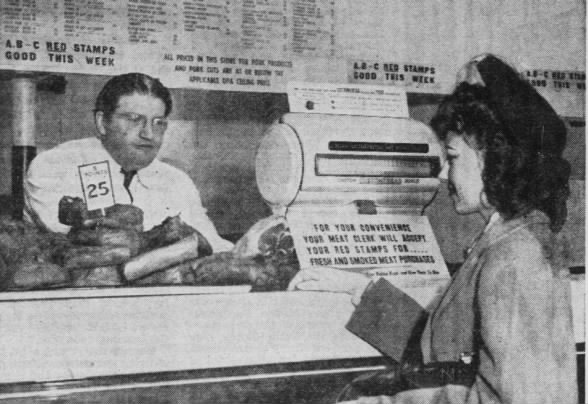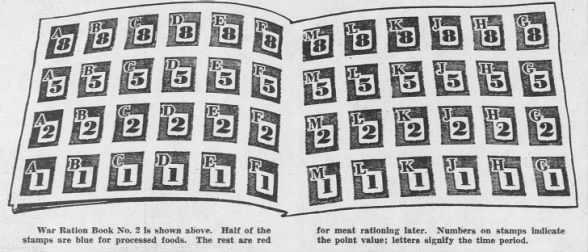 Shopping for meat during rationing 16 Apr 1943, Fri Detroit Free Press (Detroit, Michigan) Newspapers.com
Shopping for meat during rationing 16 Apr 1943, Fri Detroit Free Press (Detroit, Michigan) Newspapers.com
World War II permeated the lives of Americans on the home front, and wartime food rationing meant the global conflict reached even into routine errands like grocery shopping. When we discovered a WWII-era shopping list in the pages of a 1940s newspaper, we became curious how food rationing shaped Americans’ day-to-day lives during the war years. So we searched Newspapers.com™ to learn more!
But first, some background on rationing in the U.S. during World War II.
Food Rationing 101
Food rationing began in May 1942, with sugar as the first item. Next came coffee, starting in November 1942. Then March 1943 saw a major increase in the number of food products that were rationed, including processed foods, meat, cheese, fats, and more.
Each rationed food item required a certain number of “points” to purchase it, with low-availability and high-demand items requiring more points. Points came in the form of coupons (also called stamps) from government-issued ration books and had to be used within a specified timeframe.
 Newspaper preview of War Ration Book No. 2 03 Jan 1943, Sun Detroit Free Press (Detroit, Michigan) Newspapers.com
Newspaper preview of War Ration Book No. 2 03 Jan 1943, Sun Detroit Free Press (Detroit, Michigan) Newspapers.com
When buying a rationed item, shoppers had to present their grocer with the correct coupons—in addition to paying the monetary cost of the item. But having enough points didn’t guarantee shoppers would be able to purchase an item, since local and national shortages limited availability of certain foods and could mean higher prices.
Grocery shopping during rationing was further complicated by the ever-evolving nature of the rationing system, with foods being added or removed and point values changing from one month to the next.
Let’s Go Shopping!
During World War II, the Detroit Free Press published grocery shopping lists to supplement its daily column of wartime dinner ideas. We’re going to explore the weekend shopping list from April 23, 1943—a challenging time for shoppers, since it was not long after stricter rationing restrictions had begun.
Let’s see what the list can tell us about life under rationing!

The top of this shopping list shows the total points needed to buy the rationed items included on it, since every American had a limited number of points allotted to them per rationing period.
At the time this list was published, Americans had recently begun using War Ration Book No. 2. Blue coupons from the book were required to buy processed foods, and red coupons were needed for meat, cheese, fats, and oils. In addition to being color coded, the coupons had their point value written on them, as well as a letter of the alphabet that indicated when the stamp could be used.

Meat rationing began in the spring of 1943, and different types and cuts of meat cost different numbers of points, based on availability. “Variety” meats, such as kidney and other organs, usually required fewer points than did other types of meat. When this shopping list was published, Detroit was experiencing a shortage of beef, pork, and lamb.

Fresh fruits and vegetables weren’t rationed. Much of the produce included on this list could be found in “moderate supply” in April 1943. Radishes, however, were in “light supply” at the time. Other common food items that weren’t rationed included poultry, eggs, fresh milk, and gelatin.

Most processed foods were rationed starting in early March 1943, including canned, bottled, and frozen fruits and vegetables. Just before this shopping list was printed, however, the point values of frozen fruits and vegetables were lowered, and those new point values are reflected on the list. Americans were encouraged to grow “Victory Gardens” and then can their own produce so processed foods could be freed up for military use.

Sugar was rationed during the war, but it required a separate coupon not based on points. Due to sugar rationing, substitute sweeteners such as honey, molasses, corn syrup, and maple syrup were popular.

No points were needed to purchase black-eyed peas or prunes (and other dried fruit) in late April 1943, since both had recently been released from rationing.

Butter, lard, margarine, shortening, and cooking oils were added to the list of rationed items at the end of March 1943. Since butter required the most points, Americans were encouraged to cook with alternatives such meat drippings—even in their baked goods.
Beyond the Shopping List
The shopping list is fascinating enough, but when we looked through the surrounding newspaper pages, a few other items caught our eye—each revealing something different about what life was like under rationing.
- A calendar reminding readers when their rationing coupons would expire.
- A column informing readers about food availability at local grocery stores.
- An article about food items whose point values had recently changed.
- A reminder to collect leftover kitchen fats for the war effort.
- Recipes taking rationed ingredients into account.
Newspapers were key to helping Americans of the WWII era understand food rationing, but the usefulness of this wartime content didn’t end when the war did. It’s still valuable today in helping us learn how our family members lived during the war years!
Learn more about WWII rationing by searching Newspapers.com™. And follow us on Facebook, Twitter, and Instagram for more historical content like this!


I have personal experience with the requirements set forth in this article.. Having experienced WW2 first hand. Three brothers in the Navy: Atlantic and Pacific Theaters and Cuba. I was usually the ‘shopper’ being the oldest at home. I recall well the rationing; the stamps for each member of the household, the ‘frozen’ food items unable to buy while ‘frozen’. The food shortages, the saving of Bacon Grease, tin foil from gum or candy, other items to make more available for the military.
Thank you for sharing your memories, Barbara! I had heard that tin was collected, but I hadn’t realized that even tin foil from gum needed to be saved!
It’s odd how comments get removed now in previous articles like they are hiding something since our President was selected.